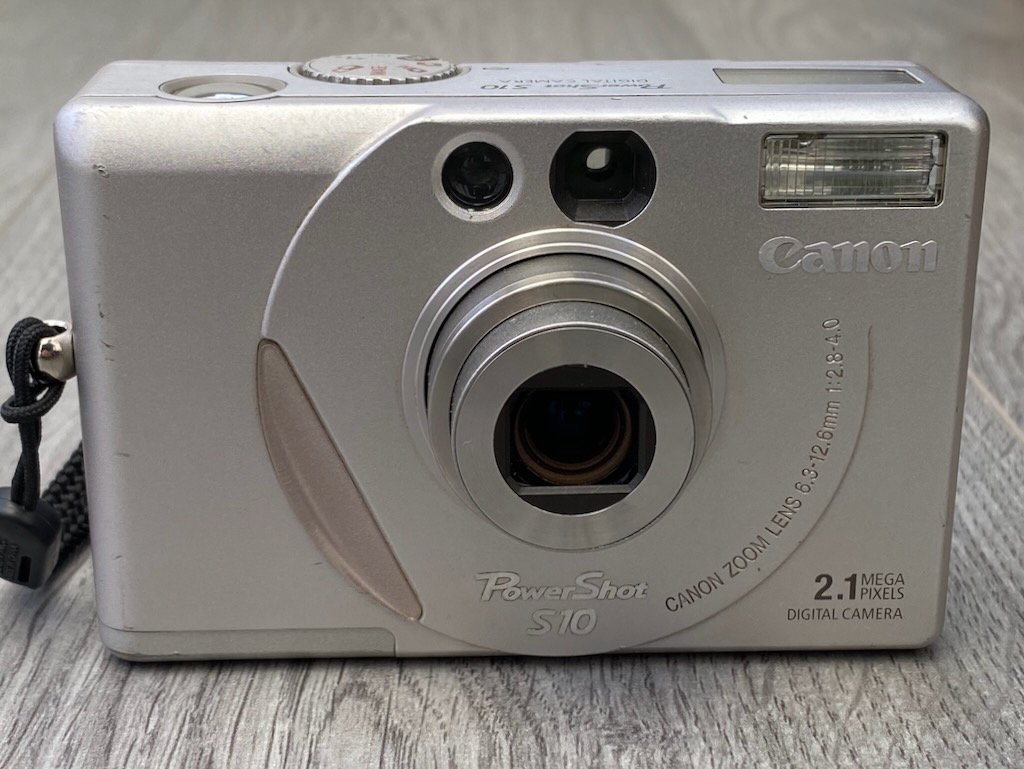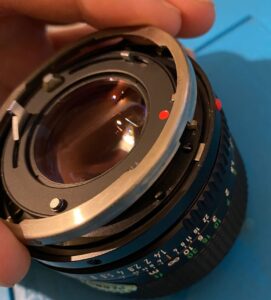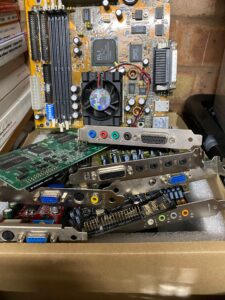Originally, the very raison d’être of this site was the enjoyment of photography on a shoestring budget, literally how much fun can you have for a crisp £5 note. As they always do, things develop and I’ve gone down various rabbit holes – such as trying out every camera in a range like the Canon T series, simply to explore the history and see how things developed over time. Recently, however, I’ve returned to my roots but in the digital compact realm.
A year ago I’d been really excited to discover that you could pick up amazing, well built, competent film cameras for a few pounds. No one wanted them and for many models, they still don’t. It turns out the exact same thing is true for digital cameras and we’ve had a fair few on this site that are just the most incredible value for money. The recent 40D with 300,000 shots on it is a perfect example – what an absolute bargain that was! Just take the time to consider how much technology, image quality and fun you’re getting for less than £10. Considering my digital daily driver is a Canon 5D Mark 1, I’d be more than happy to use one of these budget bargain SLR’s like the previously reviewed 20D or 30D.
I recently picked up two cameras from 2001 that I’d used as a teenager – the Fujifilm A201 and Olympus C860L. The motivation for revisiting those is quite obvious, but searching for one thing from your youth inevitably leads to looking for others and so it was I found myself on eBay again having a look to see if there was a single, working Canon Ixus 500 left in the world – my first “real” digital camera. Allow me to save you the hassle – there aren’t any and that is no surprise because every single Ixus 400 and 500 was fitted with a dodgy sensor from the factory that eventually gives you purple images or no image at all. If you do have a working ixus 400 or 500, you won’t for long.
For reasons that I can only explain as “being in the interest of historical research” I started to wonder what the oldest Canon digital compact was and this led me back to the Canon Camera Museum and then to an auction for one of the early (but not quite earliest) “prosumer” digital compacts – the Canon PowerShot S10. For £15 all in, it was more expensive than I’d ideally have liked for something so obsolete, but it was worth it for a “tested” working model to have a play with.
What was it like to spend £550 (£1006 inflation adjusted for 2023) on a digital compact in 1999? Let’s find out.
In this review:
- The explosive birth of digital compacts
- Buy cheap, buy twice the batteries
- Feel the power(shot)
- Conclusions and learning
The explosive birth of digital compacts

Things were really kicking off in the world of digital cameras in 1999 to 2000 as the technology was simultaneously coming of age and down in price. Battles raged both online and off about the various merits of digital versus film, to the point where some traditionalists were convinced that digital cameras did not produce photographs but “light art.” Photography was the preserve of film, darkrooms, enlargers and the mystical witchcraft that goes into producing prints.
In 1999, 1 megapixel digital cameras were seen as very capable units and they were still selling well two years later when, in 2001, digital sales in the UK finally surpassed film for the first time. Incidentally, what was the most popular camera that month? The venerable Olympus C860L that we reviewed but a few weeks back. One of the contributors to Amateur Photographer magazine had even taken one to a war zone to do some reportage and documentary.
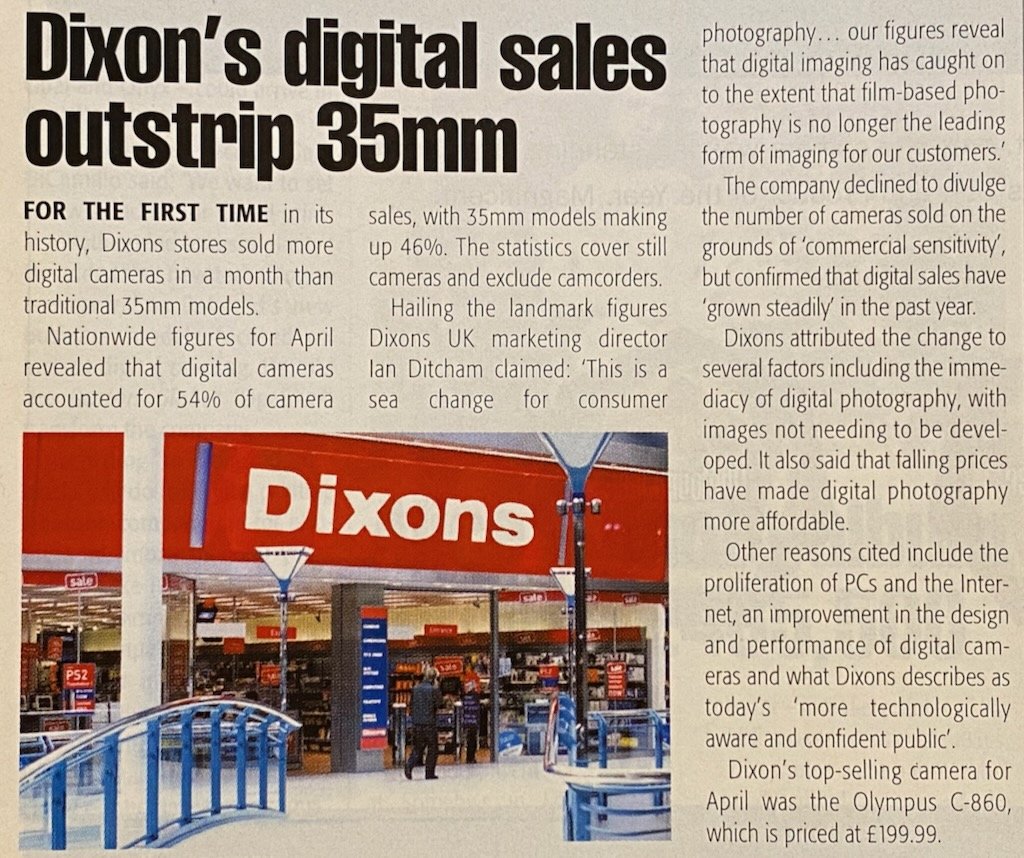
Although the transition from film to digital was relatively prolonged, the pace of product launches and developments was as stereotypically rapid as you may expect for the technology sector at the turn of the millennium. Canon already had a winning formula with its extremely popular Ixus APS film compacts. These beautiful metallic boxes sold in their millions and customers loved the pocketable form factor for its convenience, light weight and half decent lens combination. It made perfect sense to copy and paste the design and bolt a screen and digital sensor inside.
The problem for quite some years was that no one seemed to know exactly what the sweet spot was in terms of price point, features, physical size and lens quality. Canon started out quite logically with an attempt to digitise their SLR range and the Powershot line of compact digitals. Things rapidly got silly and within the space of a year the Powershot range quickly split into Powershot A, S, G and Pro models with the brand new Digital Ixus range as a cherry on top.
I spent a while digging around the Internet Archive trying to work out exactly what or who each part of the Powershot range was targeted at and the answer was… well, anyone with the correct amount of cash really. The “A” series was for “business and internet users”, the S for, er, “serious compact users who want to replace film” and the G was for “semi-professional users who want a camera built on Canon’s 60 years of photographic experience and knowledge.” Oh… so was the Pro, that’s for “semi-professionals” as well. Honestly, who knows.
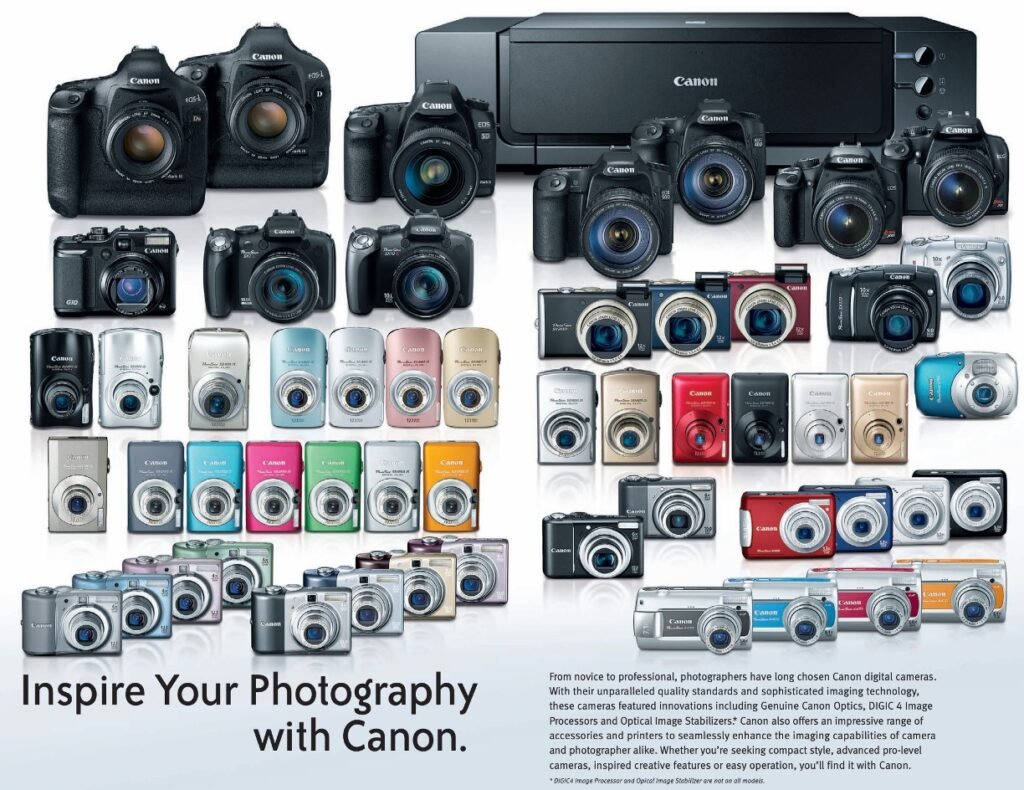
History shows us that the Ixus immediately cannibalised the early S10 and S20 cameras as they effectively merged, leaving the S series to grow ever larger in the name of being more fully featured but, honestly, having used a later Powershot S40 it was basically an Ixus 400 in a larger case with a slightly better lens. Hmm. It never got any more sensible or organised and for over a decade Canon pumped out compact after compact at a seriously impressive rate, covering everything from rainbow coloured selfie specials, tiny super zooms and “bridge” cameras that could do everything but change lenses.
This is why I do love a bit of nostalgia. The further back in history we go, the simpler life gets. Choices are confusing, I like simplicity.
Buy cheap, buy twice the batteries
I love eBay. The sellers are always an honest bunch which really takes the stress out of buying and avoids any potential disappointments.
Yeah. No…
Check out the description of the S10 I bought:
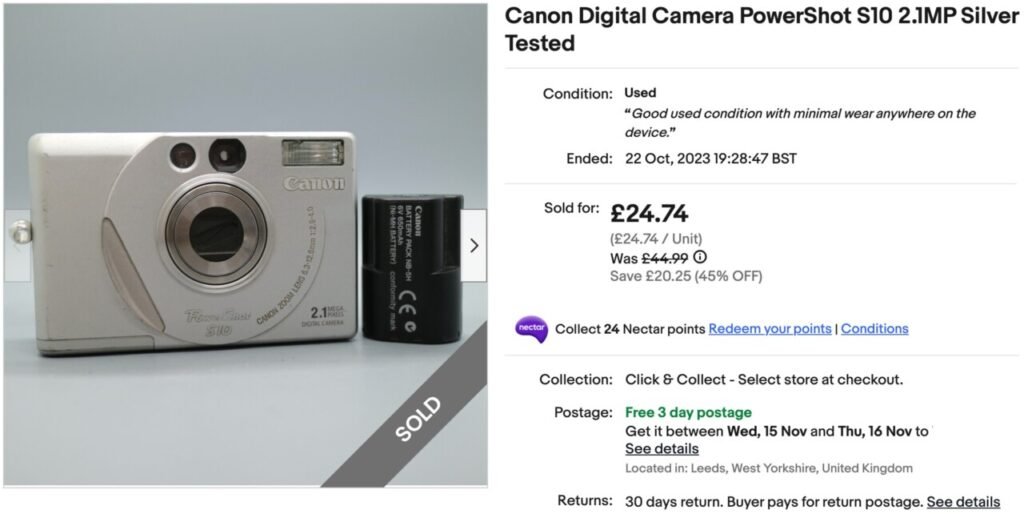
The seller here wasn’t technically lying when they said it had been “tested” and showed it powered on in the pictures. I bought this particular S10 simply because it came with a battery and so many of these are without accessories like a charger – complete models attract the usual “collectors” premium. I knew that by now the battery wasn’t going to be in great shape and I would’ve accepted poor performance if it lasted a reasonable number of shots before dying.
The battery supplied held enough charge to turn on for around 15 seconds. I admire the seller for being quick enough to take the “working” shots before it powered itself down again. This is a shame as a little more honesty would’ve led me to buy an altogether cheaper model and source my own battery. As it was, I drastically increased my carbon footprint for the year by ordering a replacement from Amazon who then promptly flew it over from Germany. This all seems a little excessive for a single battery.
The overall body condition was acceptable bearing in mind that these cameras were designed to live in trouser and coat pockets. No twenty year old compact camera is going to be shiny and new unless it has seen next to no use for some reason. This one had certainly seen some better days, however. Someone had clearly not understood how the memory card door works and it has been almost snapped in half where some over zealous prying had taken place before the crushing realisation must’ve set in that perhaps there’s a very obvious slider next to the door that flips it open. Then, the first time I powered it on there was a nice metallic clink as part of the lens surround fell off. The metallic casing of the body itself was in desperate need of its first clean in at least a decade. You know what’s coming next – alcohol bath and a scrub.
The final niggle was a dead clock backup battery. The S10 takes a very thin CR2016 battery to keep the settings, date and time when you take the main battery out. It’s really, really frustrating if you don’t replace this because every time you turn the camera on it’ll pop up with the date and time settings when all you want to do is take a picture. Completely coincidentally I’d rescued a couple of these batteries from an old remote key fob some weeks before and one of them still had enough power to satisfy the S10.

I don’t know why the listing says it sold for £24, it absolutely didn’t and this may well explain some of the skew between historic average sold prices and the prices ebay recommend you try to sell your items for when you list your own. It may also explain the absurdly inflated original asking price this seller was trying to achieve. Anyone willing to spend £45 on one of these is perhaps in need of a quiet lie down in a dark room.
Feel the power(shot)

Stop for a minute and consider that the Powershot S10 was only Canon’s 6th attempt at a compact digital camera in three years since the launch of their very first 0.5MP model. This was also their first 2.0MP digital camera and just happened to be the smallest compact available when released in late 1999. In that context, it is a remarkable piece of engineering and a fantastic embodiment of the utterly mad pace of development that most technology underwent during that period in time.
Due to the common design language that Canon carried through from the APS film Ixus line and through to later digital Ixus models, I felt instantly at home with the S10. I didn’t feel the need to read any manuals nor consult any kind of reference – you can just pick it up, swivel the dial to the shooting mode you want and off you go. Any changes to settings are easily dealt with in the menus, navigated with the simple four way controller.
The addition of a top LCD panel seems like a nice feature and for those transitioning from film they’d have probably welcomed this as a sensible, useful addition – especially for a quick reference as to how many shots were remaining on the rather limited 8mb flash card these used to ship with. Being as it’s 2023 I filled my S10 with a positively outrageous 512mb Sandisk card and the camera reported well over 700 shots capacity – something that would’ve been both amusing and absurd to even think of in 1999. I must admit, however, that I never made any real use to this secondary display and it isn’t surprising that future models very quickly did away with it.
There’s no getting away from the real reason there’s a cute information LCD in addition to the main screen – to get you to turn the display off. The S10 is hungry for batteries and God help anyone who went down the road using one with the 2CR5 batteries. You’d have needed a second mortgage to keep this thing going with disposable power cells. The compatibility with disposable cells is a nice touch and certainly may have got you some shots in an emergency on holiday perhaps, but to use it as a main power source is bonkers. On a brand new battery that has been fully charged you’ll be lucky to get more than a few hours use out of it and certainly no more than a days shooting out and about if you’re careful with the screen, review modes and so forth.

In nearly all of the early Canon compact digital cameras, they’d introduced one killer feature – stitch assist. I love this mode. Stitch assist allows you to create panoramic images by showing you half of the last image taken on the display so you can perfectly line up the next shot. The Powershot S10 features an enhanced version which allows left to right, right to left, up and down and square (top left, top right, bottom right, bottom left). There’s something about this mode that captivates me. I’m utterly awful at spotting and taking decent panoramas so normally I don’t bother doing them with any other camera, but if you put a Canon compact in my hands the first thing I’ll do is flick on stitch assist and start whacking images together.
This mode never made it past the Ixus 500. Future models simply dropped it for no apparent reason and I think that’s a massive shame – why drop a feature that works and would genuinely be useful to people using point and shoot cameras? It makes little sense to me. Regardless, the stitch assist mode on the S10 really comes into its own as you can overcome the wide end of the lens not being quite wide enough for some situations. With a 2MP resolution, you can create some really rather large panoramas that take up very little space. Did I mention I really miss this in modern cameras? I really miss this…
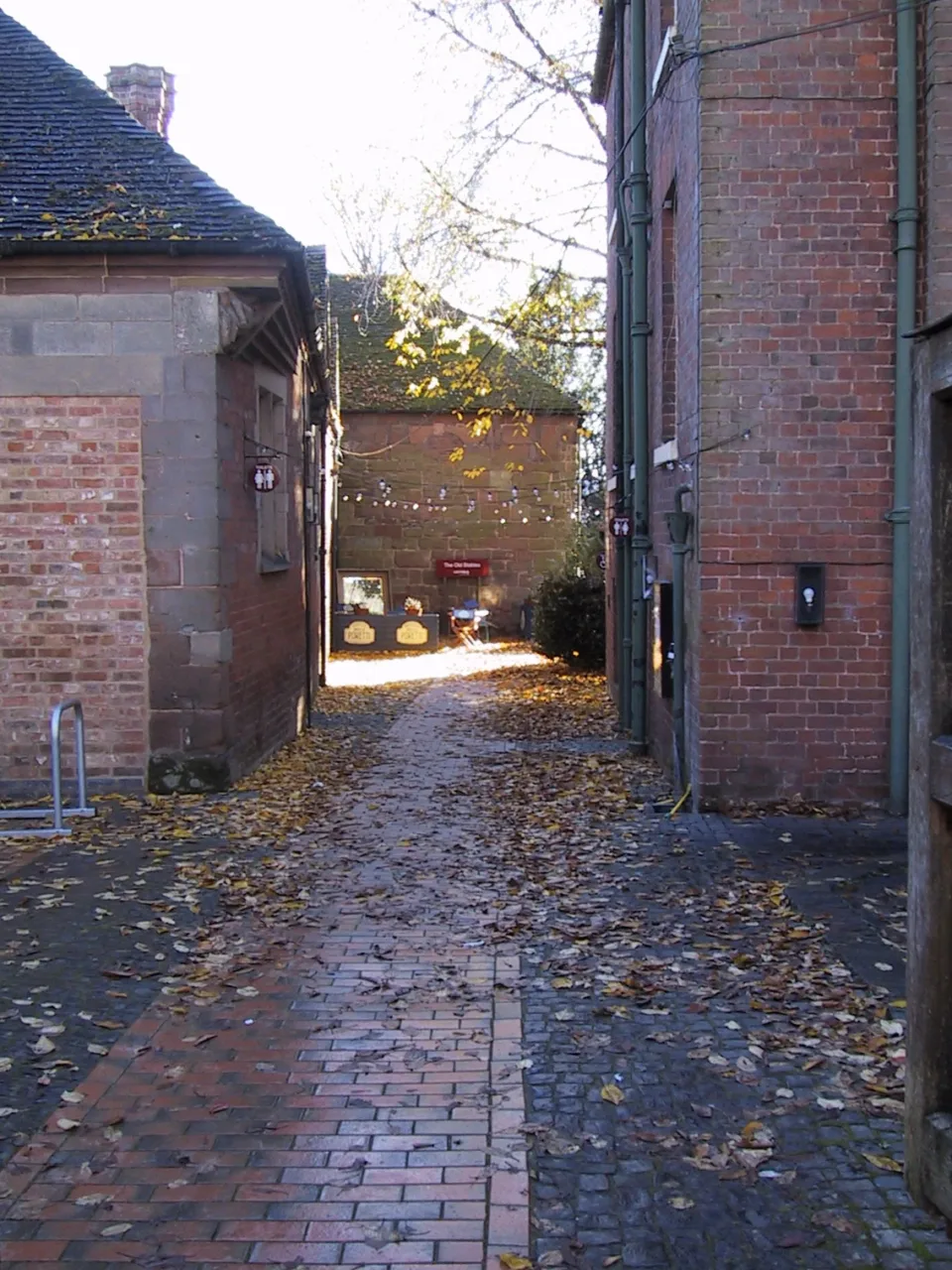
Image quality is good for such an early digital camera and was widely praised for this at the time of release. The image above shows some of the challenges that faced a digital photographer in the late 1990’s. Dynamic range isn’t anywhere near the modern standards we’re used to today. The camera rightly chose to expose for the shadows and the compromise is a blown out sky – it isn’t the end of the world and just shows how finely developed sensor technology is today. There’s some purple fringing around highlighted areas and there simply isn’t the resolution to bring out that really fine detail like distant brickwork and the sign.
In less challenging situations, however, there are almost no weaknesses in the shots the S10 creates. It is no wonder that reviewers were so excited when they tried it out. The quality of some indoor shots I took were nothing short of remarkable. There are companies in 2023 pushing deliberately low quality digital cameras that produce visibly, measurably worse images in the name of “retro” look and feel, apparently that’s a thing now. Why? There are definitely some cameras from the early days of digital compacts that are utter garbage or have such low quality sensors that they create “pleasing” blur, colour casts and other defects. Why would you want one?
The S10 makes something of a mockery of this kind of nostalgia because here’s proof that you did have options that were properly decent and as a bonus, the S10 has the subtleties in its images that mean you can tell it’s a “retro” camera. If you want that look for your pictures or a project you’re doing, why on earth you’d buy a modern recreation is hard to understand – just buy the actual models that were available at the time – no one wants them and they’re pennies to buy.
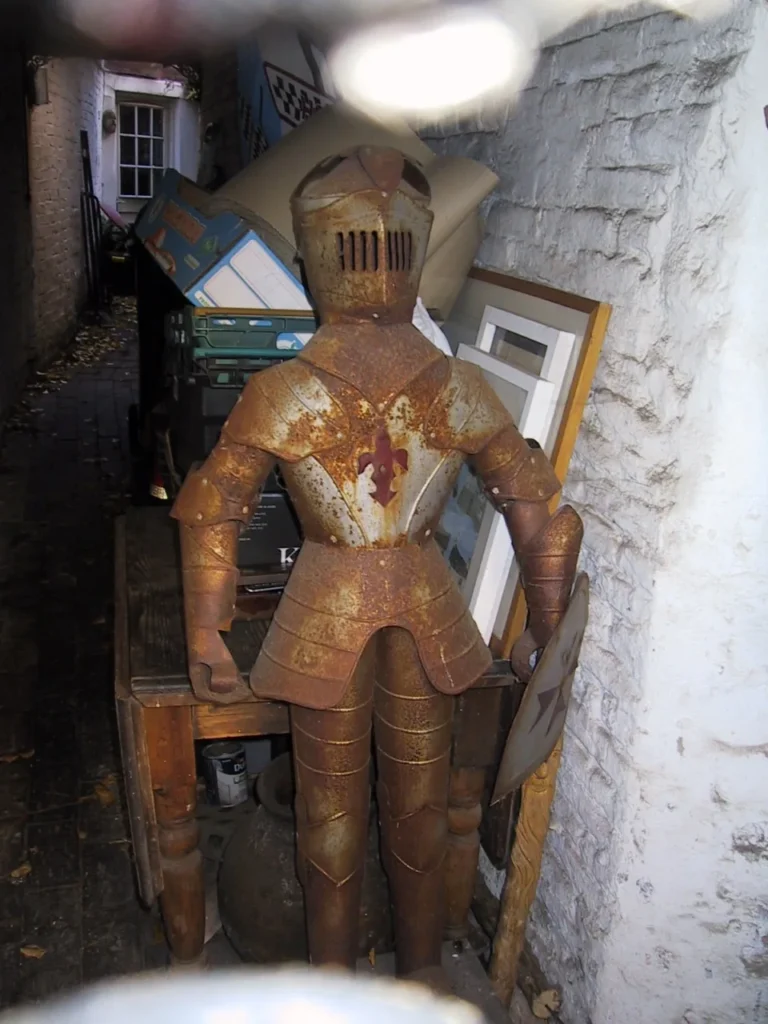
The S10 is a pleasure to use but by no means perfect. The problem with using old cameras in retrospect is that we are spoiled by the expectations that progress has ingrained in our brains. Any weaknesses are emphasised far more now than they would’ve been at the time because we know what camera performance should feel like. However, I’m certain that anyone coming from a decent film SLR at the time would have been surprised by some of the delays that digital photography introduced in its infancy.
Processing power was certainly not quite up to the job in the S10. It isn’t sluggish to the point of being jarring, but there are delays in start up and longer delays still when an image is taken before it can appear on the display. The oddest quirk the camera has is that there isn’t any instant image review when a picture is taken. If you’re using it with the screen off, which is a lot of the time, it is next to impossible to know whether an image has been taken or not – the real world is often far too noisy to hear the subtle *click* as the image is taken.
Conclusions and learning
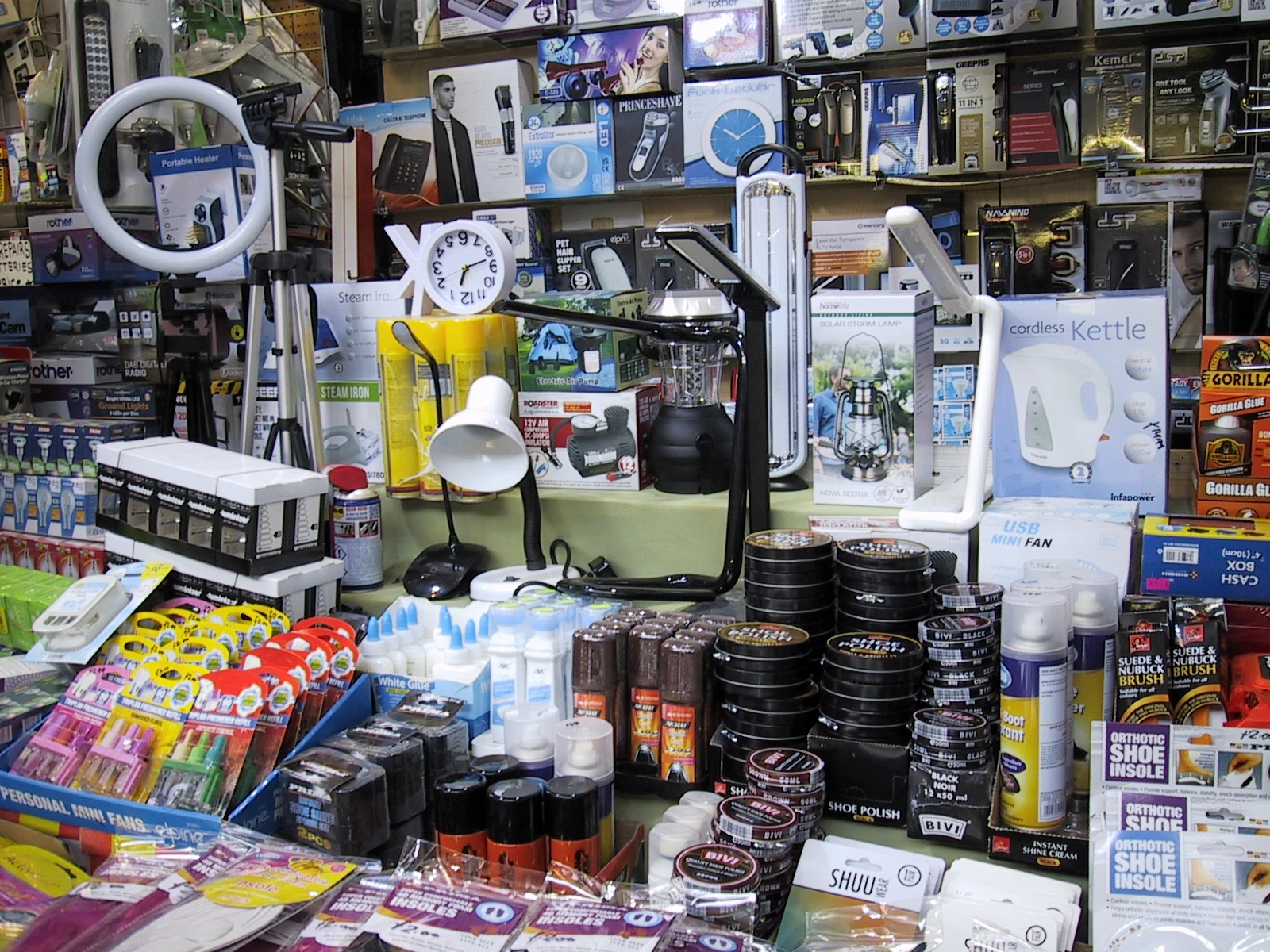
There’s no doubt that the S10 was something of a revelation at launch. This compact marvel seemed to fit an extraordinary amount of photographic power in an unfeasibly small package. Canon knew that materials matter and the lack of plastic goes a long way to convince you that this is a serious photographic tool.
The S10 is one of the nicest built, quality feeling digital cameras on the market, with it’s all metal exterior and tiny proportions it’s both convenient and rugged. Taking photos is a joy, the camera is fast and responsive, LCD is bright, clear and non-reflective (and about as big as you could expect in such a small camera).
DPReview – November 1999
Of all the compact digitals I’ve used lately the S10 is leagues ahead. Size really does matter – this was surely one of the first digital cameras that made it totally feasible to carry everywhere, to always have on hand for a potential photo opportunity that may arise. As a travel companion, the S10 would’ve been a formidable investment and I’d wager many a memory on trips abroad were captured by these cameras.
The feature set is almost perfect. There’s automatic modes if you want them and a reasonable amount of manual control that falls just short of giving you full aperture/shutter speed control and that’s ok in a compact – compromise has to be made somewhere. The controls are comfortable and conveniently placed, the screen was good for the time and totally awful by todays standards!
Battery life is the real problem, as it was when launched. No one ever suggested that batteries lasted a long time when the S10 was brand new, and nothing has changed even with a brand new replacement today. Of course, you could alleviate this by carrying several spares and just rotating them but it certainly brings home just how good lithium-ion cells have made our lives since the days of ni-mh and nicad.

The S10 was certainly revolutionary and plenty expensive in 1999. Subsequent models all built on the foundations, each iteration increasing resolution, processing images faster. The S10 evolved into the S20 which then kind of morphed into the wildly successful Ixus line that really did create the perfect blend of size, function and image quality. At 2MP, though, the S10 is just that little bit out of its depth today for anything beyond a nostalgia hit.
I had a blast using the S10, I’ve finally got another compact Canon that has stitch assist and I’ll probably keep it and occasionally use it for just that one reason. There’s no logic to that at all, but it is what it is. For £25 ish including a new battery, it’s been a great budget experience and fun to use what was once a very expensive piece of history. Now, there’s something sitting on my desk with “eos” written on it that really does need my attention and a roll of film running though it…
Share this post:

